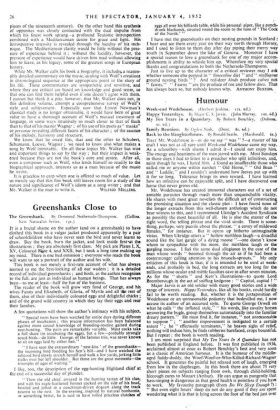Greenshanks Close to
The Greenshank. By Desmond Nethersole-Thompson. (Collins.
New Naturalist Series. i Ss.)
IT is a brutal shame on the author (and on a greenshank) to have clothed this book in a vulgar jacket produced apparently by a pair of schoolchildren who have never seen the bird and never learnt to draw. Buy the book, burn the jacket, and look inside first•at the illustrations ; they are absolutely first class. My pick are Plates I, X, XV, Coloured RJjte 4, and XXII, but I took a lung time making up my mind. There is one bad omission ; everyone-who reads the book will want to see a portrait of the author and his wife.
This book is not merely a first-rate account of what has always seemed to me the best-looking of all our waders ; it is a detailed record of individual greenshanks ; and birds, as the author recognises to the full, are just as individual as human beings. That has always been—to me at least—half the fun of the business.
The reader of the book will grow very fond of George, and his wives Fanny and Elizabeth, of Gloria, of Myrtle and all the rest of them, also of their individually coloured eggs and delightful chicks ; and of the grand wild country in which they lay their eggs and rear their families.
A few quotations will show the author's intimacy with his subject.
" Special nests have been watched for entire days during different phases of incubation ; this precise information has been balanced against more casual knowledge of brooding-routine gained during nest-hunting. The pairs are remarkably variable. Most cocks take a full share (in incubating the eggs), but a few—probably strongly sexed birds—do little. George, of the famous trio, was never known to sit on eggs laid by either hen."
" I have seen the extraordinary nest-kiss ' of the greenshanks- the incoming bird fondling his hen's bill—and I have watched the relieved bird slowly stretch herself and walk a few yards,.jerking little stalks over her left shoulder. But those are the great moments—the triumphs of ages of waiting."
I like, too, the description of the egg-hunting Highland chief at the end of a successful day of plunder.
" Then the old chief, arrayed in the hunting tartan of his clan, and with his eagle-feathered bonnet cocked on the side of his head, bowled and jolted in a coachman-driven dogcart along the track nearest to the nest. In the-evening, inspired by natural bonhomie, or something better, he is said to have rolled priceless clutckes of
eggs all over his billiards table, while his personal piper, like a punch- drunk blackcock, strutted round the room to the tune of The Cock of the North.' "
I have met the greenshanks on their nesting grounds in Scotland : I hear and see them every year on their way north through Horsey, and I used to listen to them day after day piping their merry way south in September down the lake of Geneva. - Moreover I have a special reason to love a greenshank for one of my major accom- plishments is ability to whistle him up. Wherefore my very special thanks and congratulations to both the Nethersole-Thompsons.
Just to live up to the character of a critical reviewer may I ask whether someone else popped in " limocoline diet " and" nialfugous ground nesting birds " ? And red-deer hinds produce calves not " fawns." " Fawns " are the produce of roe and fallow does. That has always been so, but nobody knows why. ANTHONY BUXTON.






































 Previous page
Previous page